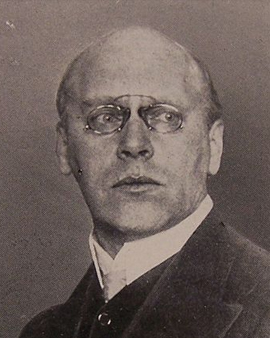Ludwig von Hofmann was a German painter, graphic artist and a creative designer of murals. Incidentally, he first inherited the title of nobility from his father, who, as a Prussian statesman, was elevated to the peerage in 1882.
His uncle Heinrich Hofmann (1824-1911) had become known as a portrait painter, who also created numerous pictures with religious and mythological scenes. Possibly he had become the model for the nephew Ludwig.
The young Ludwig found his studies at the Academy of Fine Arts in Dresden since 1883 unsatisfactory for his development. Therefore, three years later he went to the Academy of Arts in Karlsruhe. With Professor Ferdinand Keller, a portrait and history painter who taught there, Ludwig finally received the optimal support he had longed for. In the end, he even became a master student at the art academy in Karlsruhe.
Decisive for the further development of his artistic life was the move to Paris. The art scene in the capital offered every opportunity to familiarize himself with the latest art styles. In Paris Ludwig von Hofmann was able to study at the Académie Julian. From the French painter Paul-Albert Besnard (1849-1934), who had been honored with numerous awards for his works, Ludwig von Hofmann was inspired for his own style of painting.
Ludwig von Hofmann was very successful as a designer of larger murals. For example, he created a monumental frieze for the Weimar Court Theater in the years 1907 to 1908. His monumental mural "Neun Musen" (Nine Muses), which he created in 1909 for the Senate Hall of the University of Jena, also became famous.
He also produced the "Euphorion Mural" for the historic Auerbachs Keller restaurant in Leipzig between 1912 and 1913. His works as a designer are characterized by their magnificently combined colors.
In addition, Ludwig von Hofmann rendered outstanding services to the design of the Art Nouveau magazine "Pan", an art magazine that was published in Germany from 1895. Among other things, Ludwig von Hofmann published some of his lithographs in it and illustrated selected poems by the lyricist Rainer Maria Rilke for "Pan" in 1898.
The painter also maintained close contacts with other like-minded poets. These included Gerhart Hauptmann and Stefan George, with whom he traveled in Italy and Greece. On the way, the artists exchanged ideas about their works. One result of the acquaintance with Gerhart Hauptmann: Ludwig von Hofmann created around 1928 numerous woodcuts to Hauptmann's poem "The Blue Flower".
The works of Ludwig von Hofmann were influenced by several art movements at the end of the 19th century. These include symbolism and art nouveau. For example, he painted many female and male nudes dancing enjoying the summer nature at the lake. His painting "Spring Dance" (tempera on canvas), created around 1915, is also impressive. Capturing harmony with nature pictorially - that was one of the main themes for the artist. A large part of his estate is now in private hands.
×





.jpg)
.jpg)
.jpg)
.jpg)
.jpg)
.jpg)
.jpg)
.jpg)
_und_Knaben_am_gruenen_Gestade_-_(MeisterDrucke-691949).jpg)
_und_Knaben_am_gruenen_Gestade_-_(MeisterDrucke-691949).jpg)
.jpg)
.jpg)
.jpg)
.jpg)
.jpg)
.jpg)
.jpg)
.jpg)
.jpg)
.jpg)
.jpg)
.jpg)
_-_(MeisterDrucke-684173).jpg)
_-_(MeisterDrucke-684173).jpg)
.jpg)
.jpg)
.jpg)
.jpg)
.jpg)
.jpg)
.jpg)
.jpg)
.jpg)
.jpg)
.jpg)
.jpg)
.jpg)
.jpg)
.jpg)
.jpg)
.jpg)
.jpg)
.jpg)
.jpg)
.jpg)
.jpg)
.jpg)
.jpg)
.jpg)
.jpg)
.jpg)
.jpg)
.jpg)
.jpg)
_Huile_sur_toil_-_(MeisterDrucke-1427693).jpg)
_Huile_sur_toil_-_(MeisterDrucke-1427693).jpg)
.jpg)
.jpg)
_-_(MeisterDrucke-1583745).jpg)
_-_(MeisterDrucke-1583745).jpg)
.jpg)
.jpg)
.jpg)
.jpg)
.jpg)
.jpg)
.jpg)
.jpg)
.jpg)
.jpg)
_-_(MeisterDrucke-1346767).jpg)
_-_(MeisterDrucke-1346767).jpg)
.jpg)
.jpg)
.jpg)
.jpg)
.jpg)
.jpg)
.jpg)
.jpg)
.jpg)
.jpg)
.jpg)
.jpg)
.jpg)
.jpg)
_-_(MeisterDrucke-691920).jpg)
_-_(MeisterDrucke-691920).jpg)
_-_(MeisterDrucke-1129349).jpg)
_-_(MeisterDrucke-1129349).jpg)
.jpg)
.jpg)
.jpg)
.jpg)
.jpg)
.jpg)
.jpg)
.jpg)
.jpg)
.jpg)
.jpg)
.jpg)
.jpg)
.jpg)
.jpg)
.jpg)
.jpg)
.jpg)
.jpg)
.jpg)
.jpg)
.jpg)
_-_(MeisterDrucke-1127237).jpg)
_-_(MeisterDrucke-1127237).jpg)
.jpg)
.jpg)
.jpg)
.jpg)
.jpg)
.jpg)
.jpg)
.jpg)
.jpg)
.jpg)
.jpg)
.jpg)
.jpg)
.jpg)
.jpg)
.jpg)
.jpg)
.jpg)
.jpg)
.jpg)
.jpg)
.jpg)
.jpg)
.jpg)
.jpg)
.jpg)
.jpg)
.jpg)
.jpg)
.jpg)
.jpg)
.jpg)
.jpg)
.jpg)
_-_(MeisterDrucke-1346822).jpg)
_-_(MeisterDrucke-1346822).jpg)
.jpg)
.jpg)
.jpg)
.jpg)
.jpg)
.jpg)
.jpg)
.jpg)
_c1898_(oil_on_canvas)_-_(MeisterDrucke-1636700).jpg)
_c1898_(oil_on_canvas)_-_(MeisterDrucke-1636700).jpg)
.jpg)
.jpg)
.jpg)
.jpg)
.jpg)
.jpg)
.jpg)
.jpg)
.jpg)
.jpg)
.jpg)
.jpg)
.jpg)
.jpg)
.jpg)
.jpg)
.jpg)
.jpg)
.jpg)
.jpg)
.jpg)
.jpg)
.jpg)
.jpg)
.jpg)
.jpg)
.jpg)
.jpg)
.jpg)
.jpg)
.jpg)
.jpg)
_-_(MeisterDrucke-1131711).jpg)
_-_(MeisterDrucke-1131711).jpg)
.jpg)
.jpg)
.jpg)
.jpg)
.jpg)
.jpg)






